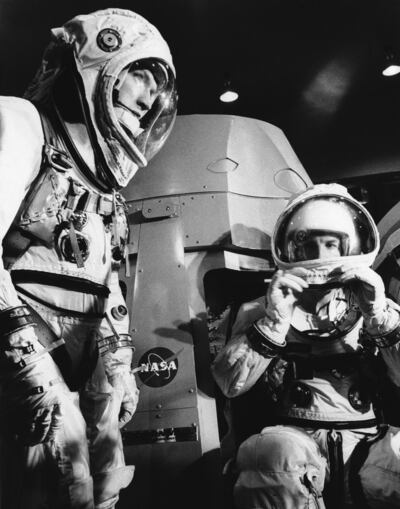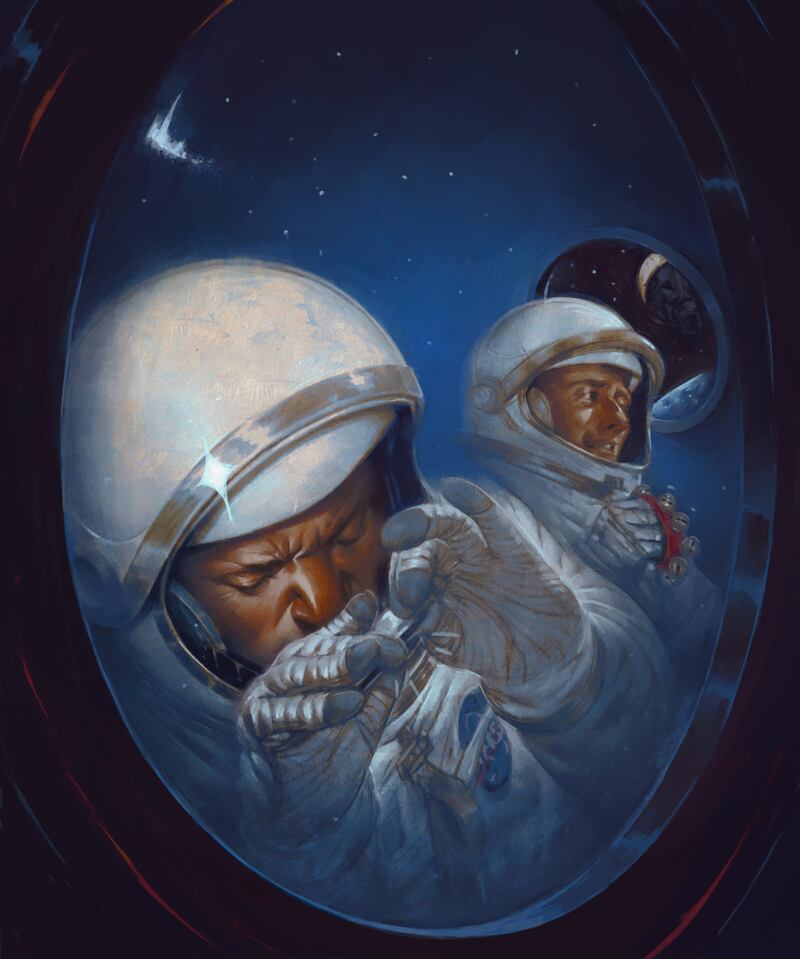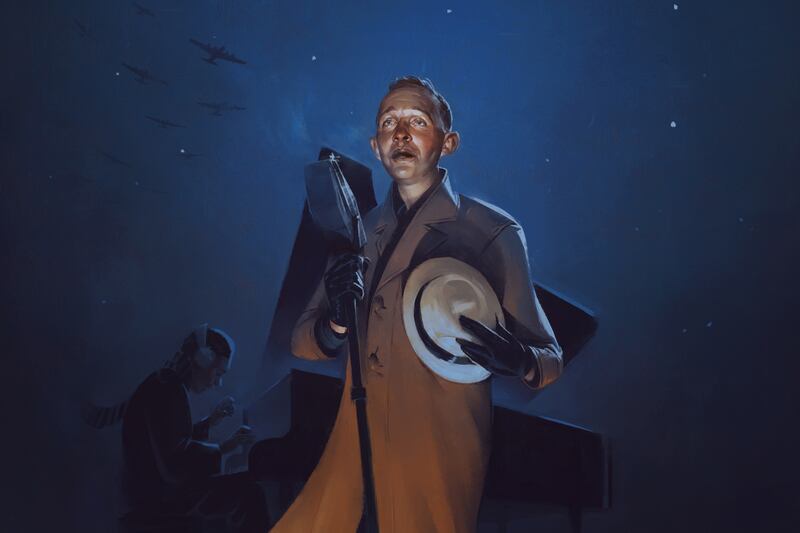The students stirred in their seats. Most didn’t know what to do with themselves. At nine years old, any unexpected display of emotion caused them discomfort. And in a classroom trailer at Taylor Elementary School in Payson, Utah, a display of emotion is exactly what greeted them on a brisk December morning in 1990. Brandon Flowers included.
There’s much about the fourth grade that Flowers can recall with ease. He and his family had recently moved to Payson from a Las Vegas suburb, leaving behind his two friends. That year brought him his first crush, first fight, first rodeo and first white Christmas. But few memories remain as effortlessly vivid as that of his teacher, Ned Humphrey Hansen, singing Bing Crosby’s “I’ll Be Home for Christmas” to an audience of awkward adolescents. Flowers watched as his teacher gazed out of a window and faced westward, careful to dodge eye contact with his students. He performed the Christmas standard a cappella and grew teary-eyed, later disclosing to his pupils that it resonated with him as a Korean War veteran. Flowers’ classmates giggled nervously. But for Flowers, something shifted. It felt like a moment he’d experience in church rather than at school. The performance was stuck on him. It still is.
Some 26 years later, after Flowers rose to fame as the frontman of The Killers, he recorded a cover of the carol for the rock band’s 2016 Christmas album, “Don’t Waste Your Wishes.” Out of the 11 songs on the record, “I’ll Be Home for Christmas” is the only cover. It includes a spoken-word history of Flowers’ fourth grade memory and is sung as a duet between himself and an 86-year-old Hansen. And somehow, the cover only seems to gain relevance. In the seven years since its release, families across the globe faced years of separation due to the Covid pandemic and now armed conflicts are intensifying in both Israel and Ukraine. Tensions have shattered any illusion of normalcy, just as they had when the original song debuted during World War II. Time and threats may change, but the appeal of nostalgia persists. Holiday music is one means of reaching for it.

A Berklee College of Music study from 2017 analyzed 78 of the most listened-to Christmas songs to parse what they had in common. It found that above all else, they shared a central theme of home. More than even love and faith, home is what listeners seek and what artists use as muse for the holiday season. That’s because music has the ability to flush brains with feel-good dopamine and elicit autobiographical memory, which places the listener back in an episode of their life associated with the song. Since holiday songs, unlike most pop music, are intrinsically tied to specific calendar events, they more immediately summon memories. Especially if those memories are directly linked to the song that triggered them. “There was something about a longing for home,” Flowers says when he thinks back to the scene in fourth grade. “Whenever I hear that song around Christmas, it conjures up those feelings and that experience.”
While music can’t solve global strife, it can offer a means of coping and connecting. The many lives of “I’ll Be Home for Christmas” — more than any tune in the yuletide songbook — are a testament to that. And it started with a rumble in the Pacific.
“I think this is what drives people literally crazy during the holidays, this nonstop pressure to be happy and joyful when you may be feeling other things around the holidays.”
The grating hum of more than 350 plane propellers above the U.S. naval base at Pearl Harbor in Honolulu signaled the surprise military attack that would kill almost 2,500 Americans and, a day later, prompt the United States Congress to declare war on Japan, marking the nation’s full engagement in World War II. Millions of men and women were shipped off to serve, both stateside and beyond. Never before had so many American families been simultaneously separated with no guarantee of reunion.
And standing in the mud to offer reprieve during that uncoupling was Bing Crosby. The vocalist joined the USO, which traveled with soldiers across Europe and the Pacific throughout the 1940s in an effort to boost military morale. Tours and events brought actors, comedians, dancers, musicians and other entertainers overseas to perform along the warfront. Of the 7,300 who made the grueling journeys, Crosby was among the most high profile; he’d spent the previous decade as both a radio and Hollywood star, playing the leading role in hits like “Pennies from Heaven.” But in spite of that success, the conditions he endured on tour were less than glamorous. Crosby ate the same food as the soldiers, wore the same uniforms, slept in the same foxholes and abided by the same military protocols. Some days he found himself atop handbuilt outdoor stages, hardly taller or more impressive than a soapbox. He’d stand to face a mass of military vehicles and an audience of troops in an otherwise desolate patch of forest. The soldiers sat in the dirt or stood to watch Crosby practically at eye level — often with helmets still on and rifles nearby, the grim reality of combat always within reach. And although Crosby performed a sampling of music from his discography, one song struck a particular chord with his audience.
When Crosby’s “I’ll Be Home for Christmas” was released in 1943, it resonated with troops for its accurate portrayal of the grief and loneliness that gripped households during wartime. The lyrics, written by Kim Gannon, are framed as a letter from the perspective of a soldier stationed overseas who is hopeful of returning home in time for Christmas. Though that wish, as reflected in the song’s final line, proved impossible for most. “I’ll be home for Christmas,” Crosby sings. “If only in my dreams.”
The ending became a source of great controversy when the song first hit airwaves. As part of a directive to limit sentimental music across radio stations in the United Kingdom, the British Broadcasting Corporation banned the single out of fear it would render troops too homesick and dispirited to fight. Though for Americans, it demonstrated the opposite effect. “I’ll Be Home for Christmas” became the most requested piece of music at USO Christmas shows and the outstanding reason for Crosby’s reputation as the performer who contributed more to military morale than any other.
Just as ancient Greek philosopher Aristotle theorized that catharsis can offer emotional release, modern science has found that sad music has the ability to produce chemicals in the brain like oxytocin to counteract feelings of pain and loss. “I’ll Be Home for Christmas” offered that outlet for listeners who related to the number. “In general, popular Christmas songs do tend to be uniformly positive and happy,” says Craig Griffeath, a musician and retired music scholar of 25 years at San Francisco’s Academy of Art University. “But (those songs) make for a less interesting emotional landscape.” “Winter Wonderland” and “Santa Claus is Comin’ to Town,” for example, offer bouncy melodies and lilting intonations, with little room for challenging truths. “There’s nothing wrong with happy music, but it’s sort of confining. … You don’t want to turn off your authentic emotional responses,” Griffeath says. “I think this is what drives people literally crazy during the holidays, this nonstop pressure to be happy and joyful when you may be feeling other things around the holidays.”
More than a song of substance, “I’ll Be Home for Christmas” and its lyrics also became shorthand for troops connecting with their families stateside, the words showing up on postcards home. “People tended to measure their war by how many Christmases they were away,” says Jonathan Vance, a professor of military history and social memory at the University of Western Ontario. “The longer they’re away, it becomes ‘I hope I’ll be home for the next Christmas.’ And then ‘I will be home for next Christmas …’ It’s almost like scratching lines on a prison cell wall. They use Christmas as a way to gauge how long they’ve been away from home and how soon they’re likely to return.” That application, one of marking time and communicating longing, persisted even long after the war ended and the postcards ceased.
The BBC banned the song out of fear it would render British troops too homesick and dispirited to fight. For Americans, it demonstrated the opposite effect.
Frank Borman and James Lovell peered out at the stars. The astronauts had spent two weeks together crammed aboard the Gemini 7 spacecraft, a cone-shaped vehicle with as much room as the front seats of an old Volkswagen Beetle. From as high as 203 miles above Earth, they’d looked down at the tops of sand dunes in the Sahara Desert, which appeared like copper rivulets. They’d seen the highways that bind South Florida glint like thin threads of silver. But in December 1965, on the final day of what was then the longest spaceflight in history, they stared out into the infinite black and imagined home.
These men would later earn international recognition for their extraterrestrial contributions — Borman for leading the first team of American astronauts to circle the moon, Lovell for becoming the first man to journey there twice. On the Gemini 7, their mission was to complete the first successful space rendezvous, a maneuver where two spacecraft meet mere feet apart to prepare for docking. The future of space exploration depended on the rendezvous, an essential antecedent to the creation of the International Space Station and to landing people on the moon. It had already been delayed by months due to failed launches and exploded ships, so program managers feared the Gemini 7 mission was next to impossible. Yet, in the early afternoon on Dec. 15, as Borman and Lovell drifted along in their orbit, their sister ship Gemini 6-A made contact. The two spacecraft soared around the Earth for five hours, at times just six inches apart. Their dance symbolized the precise moment the United States pulled ahead of the Soviet Union in the space race.

The two crafts only spent a day together before Gemini 6-A returned to Earth, leaving Borman and Lovell alone for another two days. And those days proved the most arduous. The Smithsonian’s National Air and Space Museum later reported that Borman and Lovell spent that time in a mental funk. The two weeks baking in an overheated cabin with electricity that threatened to fail took a toll on the astronauts. As they hovered above everything and everyone they knew, Borman likely thought of his wife waiting for his return, and Lovell of his wife and three children, both astronauts longing to be on terra firma again.
So much so, when the final day came, and NASA communications personnel asked what music they wanted to serenade them on their descent, only one song was up to the task.
As Borman and Lovell began their reentry, hurtling toward home at some 17,000 miles per hour, they could hear the sound of Crosby’s voice. “Christmas Eve will find me,” he sang. “Where the love light gleams.”
“In the 1940s (Christmas) became idealized as the perfect extended family experience of togetherness and harmony.”
Mere days after the first Christmas of the Covid pandemic — one that coincided with incessant airline cancellations and quarantine restrictions — the song appeared on the Billboard Hot 100 charts, coming in at No. 50. And for however fleeting of a moment, a 77-year-old carol released by a wartime crooner outranked more modern artists like Cardi B, Eminem and Justin Bieber. That trend will likely continue.
Holiday songs from past generations tend to outrank more modern renditions. Two-thirds of the songs that have lingered on Billboard’s Holiday 100 chart for more than a decade were released before 1980. So-called Christmas standards have informed how the holidays are now celebrated and understood. They’re foundational, which grants them more longevity than most other musical canons. “The appeal to longevity ties into a nostalgic vein that also exists with Christmas,” says Michael Foley, a professor of patristics at Baylor University and author of a book on Christmas traditions. He argues songs like “I’ll Be Home for Christmas” from the 1940s placed newfound emphasis on seasonal values of family and home. “I think it contributed to a trend that already began, which was the domestication of Christmas and the trend to make it more innocent and sentimental.” Vance, the military history and social memory professor, agrees. “In the ’20s and ’30s and before the First World War, I wouldn’t say that Christmas was as big a deal as it became in wartime,” he says. “In the 1940s … it became idealized as the perfect extended family experience of togetherness and harmony.”
But the impulse to listen to Christmas music is one that extends beyond Crosby’s carol, and beyond Christmas itself. Every major religion significantly incorporates music. People across cultures have crafted tools like trumpets made of ram horns called shofars and organs forged of metal to bridge both song and worship. And while there’s no clear evolutionary reason as to why humans are so drawn to man-made melodies, music is estimated to have existed as long as our species has. Objects thought to be early flutes chiseled from bone date back tens of thousands of years; fossil records show our ancestors have had the anatomical ability to sing for hundreds of thousands.

On radio stations and playlists, “I’ll Be Home for Christmas” remains a reliable holiday staple every year. It’s been featured in the “Looney Tunes,” “Gilmore Girls” and “Star Trek” universes; it’s been covered by the likes of Frank Sinatra, Tony Bennett and Michael Bublé. Sometimes, it even finds itself in unexpected places, like a classroom trailer in Payson, Utah.
When Brandon Flowers thinks back to the first time “I’ll Be Home for Christmas” stirred him, he thinks of Ned Humphrey Hansen, who died in 2021. He thinks of his teacher’s tears, his first December snowfall, his home old and new. And he thinks of the many lives the song has lived. “It still stands out to me as this time where music moved me,” he says. “It’s … deeper having that twist of the connection to the military and to the sacrifice that these people are making.” Though now he can also reflect on his own addition to its legacy. Despite all the stories assigned to it over the last eight decades, and all the new associations to follow with every additional play, the track remains somehow both timely and timeless. Though perhaps that says more about the listener than the song.
This story appears in the December issue of Deseret Magazine. Learn more about how to subscribe.


